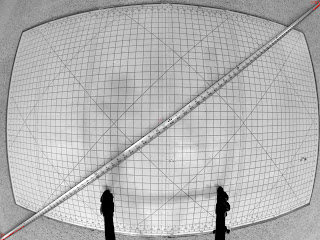Transit of Mercury, May 9, 2016
Today (well, technically, yesterday now) was the 2016 Transit of Mercury. These happen much more frequently than transits of Venus. Mercury transits happen about every 7 years (13 or 14 times per century). I was watching the weather anxiously - I wanted this to be a dry run for the 2017 eclipse, but I was not able to travel on Monday so I was hoping that the weather would suffice here in Fort Collins. I watched the Fort Collins cleardarksky page continuously over the weekend, which helped me stay calm and collect my equipment to prepare for the expedition.
Monday morning started with low clouds which cleared by about 6:30 or so - just in time for me to have all my equipment set up:
From left-to-right, these are:
via GIPHY
And here are two videos on YouTube. First, white light:
Next, H-Alpha:
And now, for bed. Nearly 24 hours after I woke up to start the excursion. 2017 is coming fast!
Edit (morning of May 10):
I also made a composite and animated GIF of the white light images. Note how the path of Mercury curves - this is because this telescope was mounted on an alt-azimuth mount. It follows the sky, but it is not aligned with Earth's polar axis:
via GIPHY
Here is what it looks like with everything rotated to correct for the "field rotation" caused by an alt-azimuth mount (especially when you track from the horizon to the zenith):
One thing to note: both the white light and H-Alpha sequences are mirror-reversed, since both telescopes have a diagonal mirror / prism in the light path. I did not bother to correct for this, since this is nothing you could see with your naked eye :-)
Monday morning started with low clouds which cleared by about 6:30 or so - just in time for me to have all my equipment set up:
From left-to-right, these are:
- A Meade 2045 4-inch Schmidt-Cassegrain telescope on a tripod, with a glass front-surface solar filter. This was for visual use - which turned out handy, since I had about 8 or 10 visitors.
- A Lunt Solar LS60PT pressure-tuned H-alpha dedicated solar scope, with a Hinode Solar Autoguider and a ZwO ASI174MM camera. These are all mounted on an iOptron CEM-60 equatorial mount. The telescope is a 60mm f/8.3, or about 500mm focal length.
- An Orion ED80TCF apo triplet, with a Baader Herschel wedge and a Canon 7DmkII attached (with a roughly 1.5x Barlow in-line to extend focal reach). The telescope is an 80mm f/6, or about 480mm focal length.
The white posterboard next to the telescopes is covering up my computer, which was controlling both the ZwO and Canon cameras. Sadly, the software I was using for the ZwO had a glitch - every so often it would decide to stop its sequence and not tell me. So I would not notice for 20 or so minutes, missing many photos :-(
A little more about the Hinode autoguider. This is a very handy device. It plugs into the autoguider port on the mount. It was about as close to fire-and-forget as you can get for solar observation. I was not able to get the mount well-aligned before sunrise (too many clouds, slept in too long), so this was a life-saver. Here is a closeup of the autoguider:
While babysitting the computer, I managed to get an iPhone shot through the eyepiece of the Meade - just to compare with what I actually got with dedicated cameras. Mercury is the smaller dot on the right:
As the morning progressed, the clouds started rolling in, much to my frustration:
That said, it was a much better day than I had been expecting the previous week. After 7+ hours out, Mercury finally slid off the face of the Sun, and I had some equipment to pack. Here are the scopes at the end of the session - see how far they rotated to counter the Earth's motion:
And now, the moment you all have been waiting for. Here is a composite picture of several moments during the transit, taken in H-Alpha light:
The two steps in the middle are closer together because of that computer glitch I mentioned earlier. Here is an animated GIF:
via GIPHY
And here are two videos on YouTube. First, white light:
Next, H-Alpha:
And now, for bed. Nearly 24 hours after I woke up to start the excursion. 2017 is coming fast!
Edit (morning of May 10):
I also made a composite and animated GIF of the white light images. Note how the path of Mercury curves - this is because this telescope was mounted on an alt-azimuth mount. It follows the sky, but it is not aligned with Earth's polar axis:
via GIPHY
Here is what it looks like with everything rotated to correct for the "field rotation" caused by an alt-azimuth mount (especially when you track from the horizon to the zenith):
One thing to note: both the white light and H-Alpha sequences are mirror-reversed, since both telescopes have a diagonal mirror / prism in the light path. I did not bother to correct for this, since this is nothing you could see with your naked eye :-)









Comments